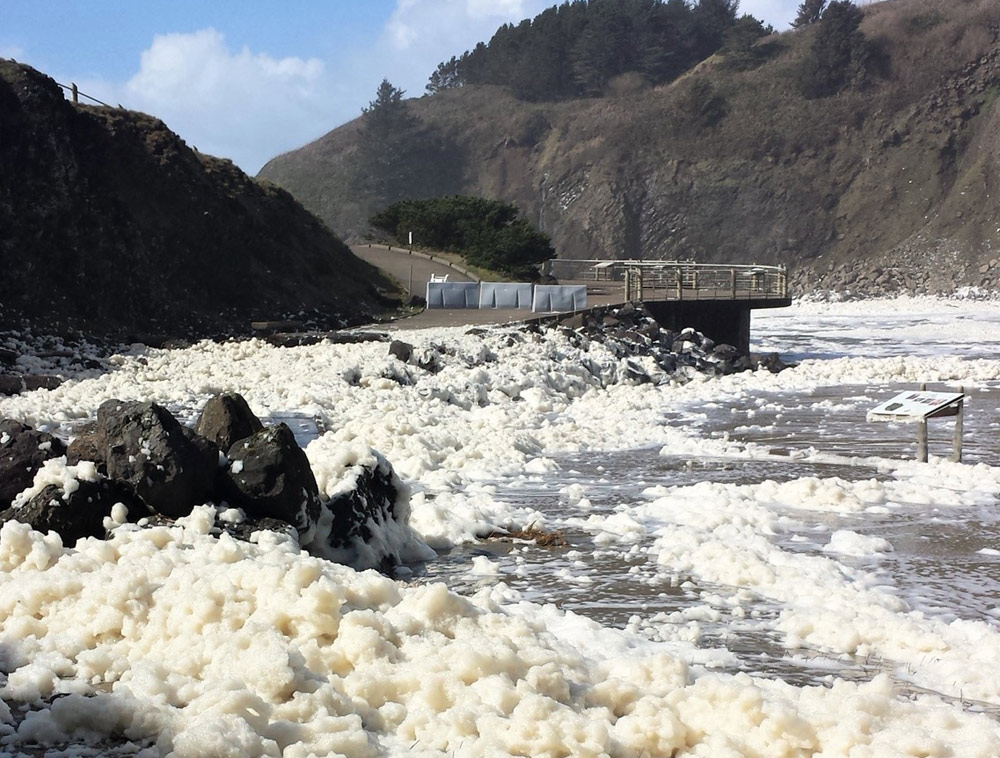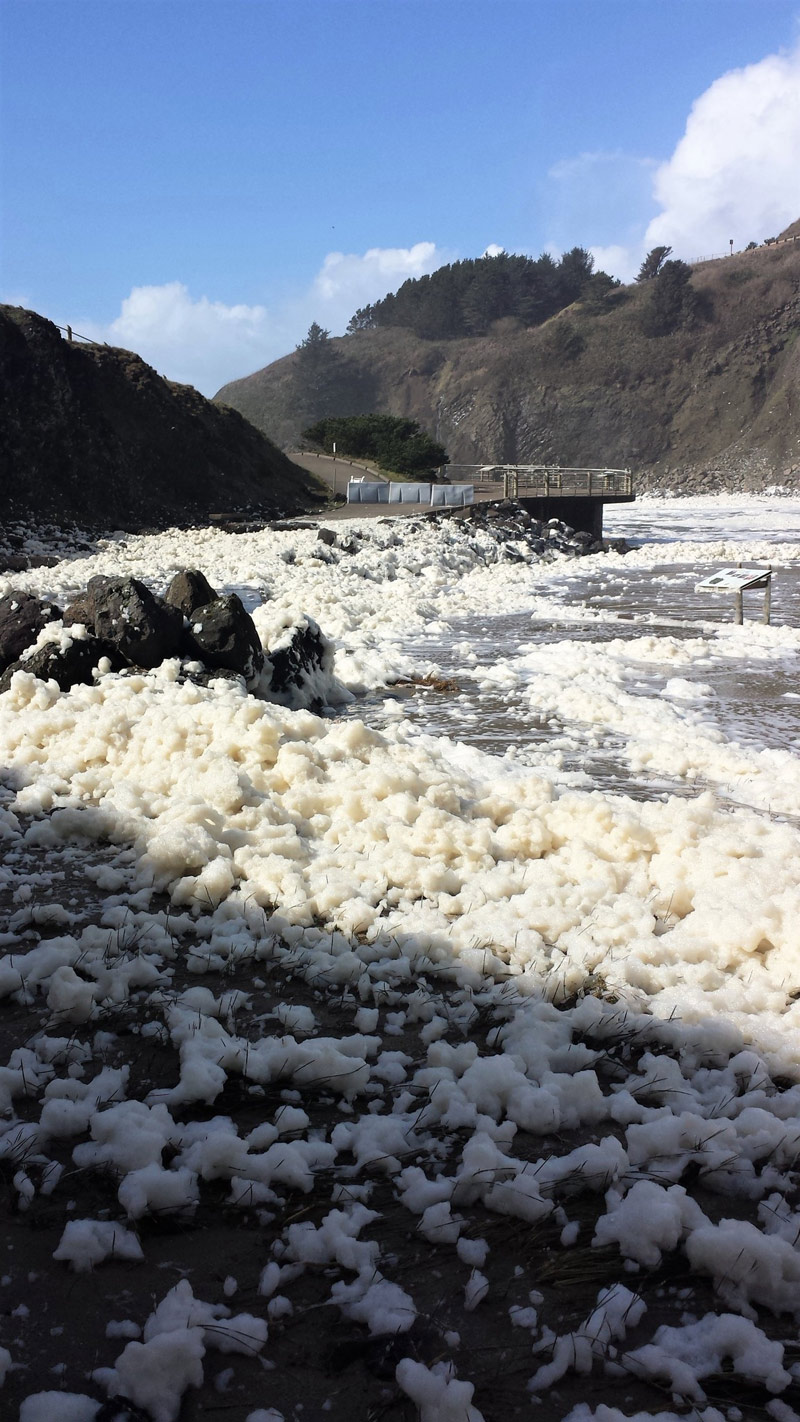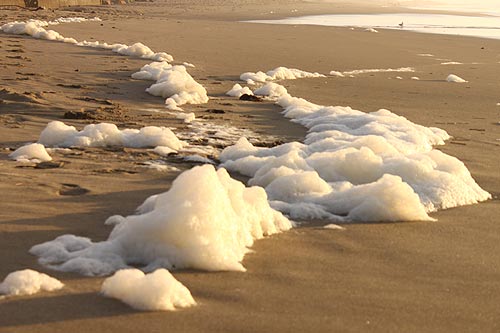The Stunts and Curious Sights of Sea Foam on the Oregon Coast
Published 11/15/23 a 5:25 a.m.
By Oregon Coast Beach Connection staff

(Newport, Oregon) – It's amazing what you can learn from just one experience on the Oregon coast. Even more amazing: some of the social media posts that are made by experts there. (Photo courtesy BLM rangers in Newport - a detail from the original below)
Includes exclusive listings; some specials in winter
In Cannon Beach:
Includes rentals not listed anywhere else
In Manzanita, Wheeler, Rockaway Beach:
Some specials for winter
In Pacific City, Oceanside:
Some specials for winter
In Lincoln City:
Some specials for winter
In Depoe Bay, Gleneden Beach:
Some specials for winter
In Newport:
Look for some specials
In Waldport
Some specials for winter
In Yachats, Florence
Some specials for winter
Southern Oregon Coast Hotels / Lodgings
Reedsport to Brookings, places to stay; winter deals
One made last week by the Bureau of Land Management (BLM) points out some fascinating examples of a weird thing that winter and spring storms may do for you out there.
In Newport, it's the feds that are in charge of Yaquina Head: the BLM oversees it. They witnessed and photographed something that can happen in winter, but not everyone sees it.
A recent storm left a lot stuff on Yaquina Head's Cobble Beach. That's already a beach with some interesting mysteries – as in those “chattering rocks” (or “magic rocks” as they're known).
What the storm left behind looked much like something else you seen in winter, causing the BLM to sort of rhetorically ask: “Is that snow on Cobble Beach?”

Full photo from BLM
No, it's sea foam, they answered. This stuff is fascinating. All that sudsy foam you see washing in on the ocean tides is mostly a lot of dead phytoplankton – a form of microalgae. There's also salts, proteins and some bits of manmade chemical residue.
Sudsy foam in the ocean is not pollution, and sometimes visitors wonder about that. It's almost purely organic bits from the ocean.
“When the ocean is agitated by large winds and wave activity, the churning adds air to the water, mixing the organic and nonorganic material and making a soap-like foam similar to a bubble bath,” BLM said.
Though when things get really foamy like this, it's quite a load of phytoplankton, a lot of times coming from a major bloom out there.
Bioluminescent Phytoplankton: What Makes Glowing Sand On Oregon Coast, Washington
According to Newport's Hatfield Marine Science Center, those tiny skeletons of phytoplankton change the surface tension of the water. The more skeletons of phytoplankton you have out there, the more surface tension and the more bubbles you have in the form of sea foam.

Blobs of snow-like foam at Devil's Churn
Sea foam can engage in some wild pyrotechnics, which Oregon Coast Beach Connection has seen firsthand. Such as one time near Yachats at the Devil's Churn, so much sea foam was hitting the rocky shoreline that it went flying like banks of snow. That cavernous shape of Cape Perpetua above forms kind of a gigantic, natural tube, and the winds caused the foam to go floating upwards, looking like snow going the wrong direction.
The BLM said something similar may happen there at the Newport attraction.
“Although the materials creating sea foam varies each year depending on ocean conditions, we can be sure to expect an increase in this frothy substance washing up on the beach as we get into the stormy winter season. It may even get blown into the air by intense Yaquina Head winter winds.”
There's an odd catch to this whole algae thing. Phytoplankton and its hugely varied species (including the kinds that create glowing sand) are a good thing and a sign of a healthy ocean. However, not all forms of algae are good.
FOR FULL EXPLANATION SEE Oregon Coast Science Experts: What is Sea Foam?
One kind off the Oregon coast and Washington coast has harmful effects on shellfish, creating that domoic acid issue that keeps closing clamming or crabbing.
BLM pointed out another issue out there.

“While usually not harmful, in 2009 a particular type of algae called Akashiwo Sanguinea appeared in the water off the Oregon and Washington coast and was found to be responsible for the death of thousands of sea birds,” BLM said. “The soap-like solution stripped the birds' feathers of their vital waterproofing.”
Oregon Coast Hotels in this area - South Coast Hotels - Where to eat - Maps - Virtual Tours
Cannon Beach Lodging
Nehalem Bay Lodgings
Manzanita Hotels, Lodging
Three Capes Lodging
Pacific City Hotels, Lodging
Lincoln City Lodging
Depoe Bay Lodging
Newport Lodging
Waldport Lodging
Yachats Lodging
Oregon Coast Vacation Rentals
Oregon Coast Lodging Specials
More About Oregon Coast hotels, lodging.....
More About Oregon Coast Restaurants, Dining.....
 Andre' GW Hagestedt is editor, owner and primary photographer / videographer of Oregon Coast Beach Connection, an online publication that sees over 1 million pageviews per month. He is also author of several books about the coast.
Andre' GW Hagestedt is editor, owner and primary photographer / videographer of Oregon Coast Beach Connection, an online publication that sees over 1 million pageviews per month. He is also author of several books about the coast.
LATEST Related Oregon Coast Articles
Includes video of a water spout beginning, other damage along Washington, Oregon
Infamous 'Bump' Somewhat Back on N. Oregon Coast Highway
Not quite as bad as last year and recently improved. Traffic, weather
When It's Like a Jellyfish But It's Not: Now Found on Oregon Coast Beaches
A few surprises about these little freaks from the deep. Marine sciences
Various Oregon Coast Road Issues At Least Partially Solved, Including OR 6
Hwy 6, 101 near Neskowin, others at least partially open. Tillamook, Coos Bay, Bandon. Traffic
This Super Full Moon is Called the Cold Moon: What It Means for Oregon / Wash...
The Cold Moon for obvious reasons, but it's bigger than normal. Weather, astronomy
UPDATE: Manzanita Declares State of Emergency After N. Oregon Coast Rains Beg...
Heavy rains saturated city-owned property, has begun to move. Weather
Central Oregon Coast's Glass Float Drops Mellow a Bit: Special Drop Dates Few...
Bringing the Lincoln City events back to their roots
Turning Oregon's Greens Into Christmas Gold: Only Days Left in Ornament Hunt
Throughout Willamette National Forest from Cascades towards Salem and Eugene. Detroit, Sweet Home, Albany, Events
Back to Oregon Coast
Contact Advertise on Oregon Coast Beach Connection
All Content, unless otherwise attributed, copyright Oregon Coast Beach Connection. Unauthorized use or publication is not permitted



















































